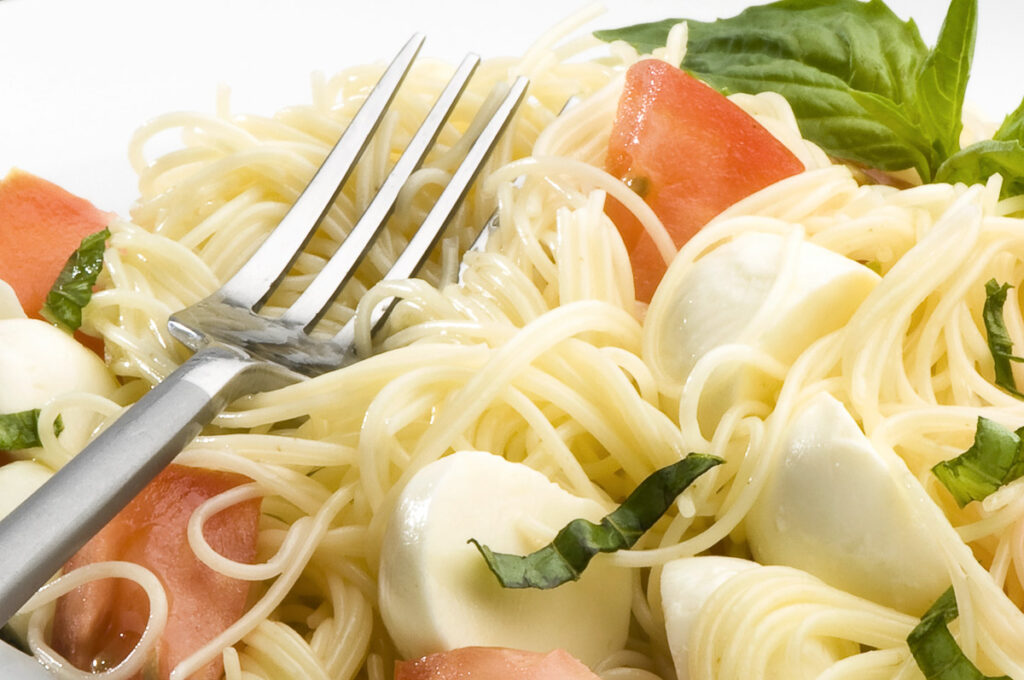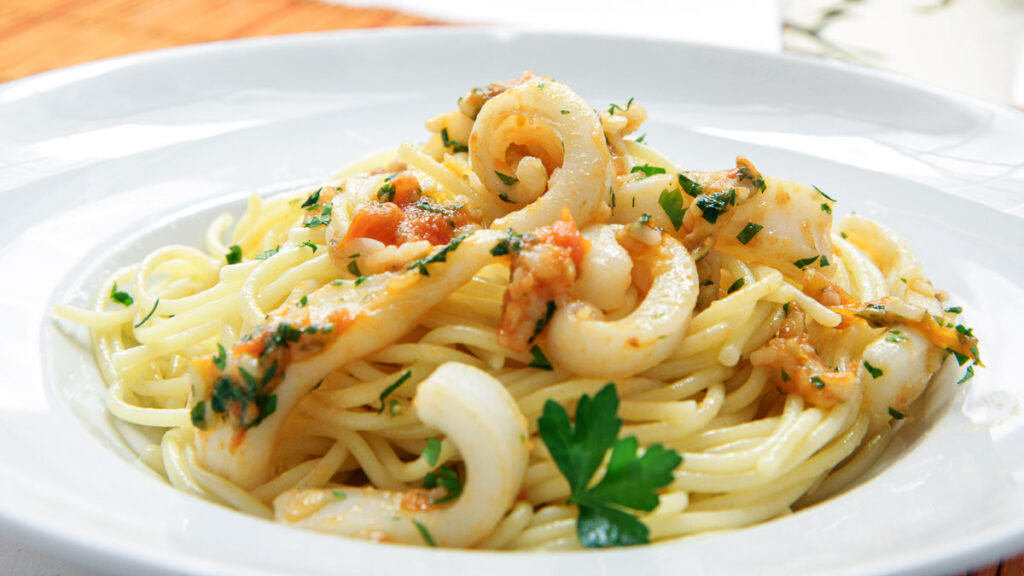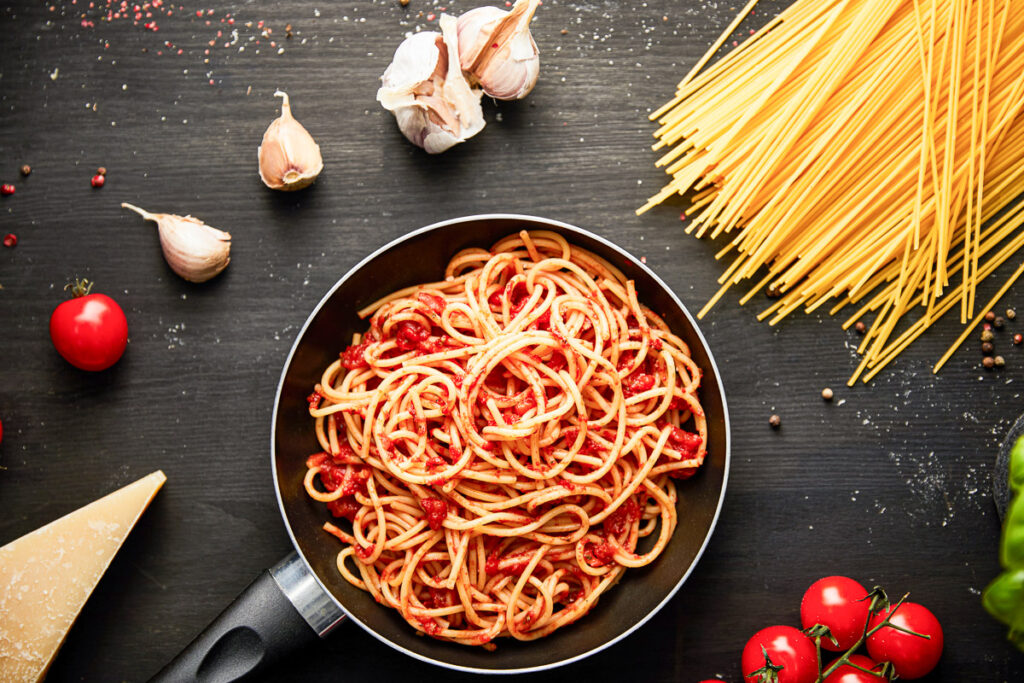Spaghettini: La Pasta Piccola
Spaghettini is often overshadowed by its more famous relatives. It is a refined and elegant pasta that deserves its place on any menu. Let’s shed some light on spaghettini, its history, and see what makes it different from other pasta. You’ll soon see if spaghetti is the king of pasta, then spaghettini has a place in the royal family.

The History of Spaghettini
Spaghettini’s origins are rooted in the rich tradition of Italian pasta making. Like its relatives, it originated in Italy and is a testament to the Italian love for varying pasta shapes and sizes to suit different dishes. The name means “little spaghetti” and was developed to offer a more delicate alternative to other traditional pasta.
Spaghettini vs. Spaghetti
The main difference between spaghettini and spaghetti is the thickness of the pasta. Spaghettini is thinner than spaghetti, with a diameter typically less than 2 mm. This finer dimension leads to a quicker cooking time and a lighter, more delicate texture. This subtle size difference may not seem like a big deal, but it influences the dish’s overall texture, flavor, and versatility. The small difference makes it a go-to option for those seeking a less hearty pasta.
Why Spaghettini?
Selecting spaghettini in cooking is often driven by a need for a lighter, more delicate texture. It beautifully combines with lighter, more refined sauces, where the pasta’s subtlety can complement without overpowering. Spaghettini is particularly well suited for simple oil or butter-based sauces, seafood dishes, and light tomato sauces.
This “pasta piccola” is perfect in dishes where its slender form can be appreciated. It is ideal for quick, light meals, often tossed with olive oil, garlic, and a sprinkling of herbs. It’s also a great choice for seafood pasta, where its thin noodles mingle perfectly with delicate shellfish, and in simple tomato-based sauces, its fine texture allows the sauce’s flavors to shine. Due to its thinner profile, it’s not as suitable for heavy, chunky sauces but can still be part of a delicious meal regardless of any sauce.
Spaghettini Basics
- Diameter: Typically around 1.5 to 1.9 mm.
- Texture: Offers a lighter bite than spaghetti but with more substance than angel hair.
- Cooking Time: Quicker than spaghetti due to its thinner size, making it ideal for fast-paced cooking.

Perfect Spaghettini Dishes
- Seafood Dishes: Spaghettini compliments seafood beautifully, particularly in recipes like spaghetti alle vongole (clams) or with shrimp and garlic.
- Light Tomato-Based Sauces: Its slender strands work well with simple, fresh tomato sauces, allowing the flavor of the sauce to be the star.
- Aglio e Olio: A classic Italian dish of garlic, olive oil, and chili flakes, where the lightness of spaghettini pairs perfectly with the simplicity of the ingredients. For a flavor of Napoli, try adding a little anchovy to this wonderful dish.
- Vegetable Stir-Fries: In a non-traditional twist, spaghettini can be used in stir-fries as it holds up well to quick cooking and tossing with vegetables and light sauces.
Pairing with Sauces
The key to pairing spaghettini with the right sauce is to match its lightness. Heavy, thick sauces can overwhelm its delicate nature. Instead, opt for olive oil or light cream-based sauces, herb-infused dressings, or simple tomato sauces with fresh herbs.

Storage and Cooking
- Storage: Keep spaghettini in a cool, dry place. Once opened, use an airtight container to preserve its quality.
- Cooking: Boil in salted water for about 6 to 8 minutes, checking for an al dente texture. It’s crucial not to overcook spaghettini due to its thinness.
Substitutions
If you don’t have spaghettini on hand, there are several alternatives you can use depending on the desired texture and flavor of your dish:
- Spaghetti: The closest substitute, slightly thicker but works well in most recipes calling for spaghettini.
- Capellini (Angel Hair): For dishes requiring a very delicate pasta. Keep in mind it’s much thinner and cooks faster.
- Vermicelli: A bit thicker than spaghettini but can be a good substitute in many dishes, especially in light seafood pasta or oil-based sauces.
- Linguine: Flatter than spaghettini, but can be used in similar dishes, particularly with seafood or pesto.
- Fettuccine: If you prefer a broader, flatter pasta, fettuccine can be used, especially in recipes with slightly heartier sauces.
- Soba Noodles: For a gluten-free option, soba noodles can mimic the texture and size of spaghettini, though they bring a different flavor profile.
Remember, each substitute will slightly alter the texture and flavor of the dish, so consider the sauce and other ingredients when selecting your pasta.
Spaghettini stands out as an ideal pasta choice, ideal for those who appreciate pasta that is neither too delicate nor too robust. Its versatility in pairing with a range of sauces and ingredients makes it a favorite in kitchens worldwide.
Editor: Oliver Baysinger.
Photo credit from Deposit Photos.
Elizabeth (Beth) Mueller is a food journalist, CEO of Pear Tree Kitchen, and co-creator of Food Blogger Help. She also has a bachelor’s degree in philosophy and a registered nurse licensed in the State of Oklahoma. When she has free time between writing, blogging, and cooking, she can be found volunteering as an RN with the Oklahoma Medical Reserve Corps.

